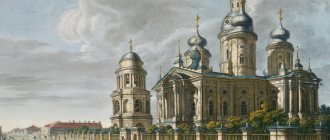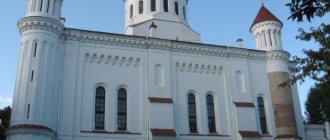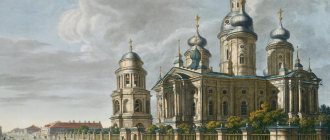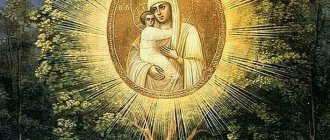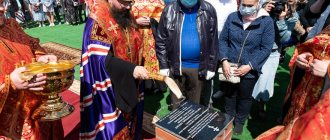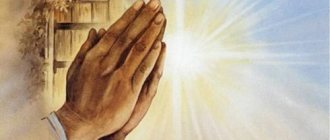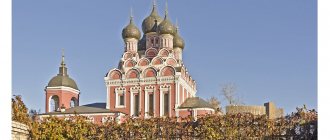Since the people of Rus' were baptized, the Mother of God has been considered the patroness of our country. From her holy images, our compatriots received miraculous help in the most difficult situations, when not only the freedom of an entire nation, but also the lives of masses of people were at stake.
One of these revered images is the Vladimir Icon of the Mother of God. Photo: ozon.ru
Threefold celebration
The Russian Orthodox Church has established three holidays in honor of the Vladimir Icon of the Mother of God. Each of these days is associated with the deliverance of the Russian people from enslavement by foreigners after turning to the Most Holy Theotokos:
- September 8 according to the new style (August 26 according to the church calendar) - in memory of the salvation of Moscow from the invasion of Tamerlane in 1395;
- July 6 (June 23) - in memory of the deliverance of Russia from the Horde king Akhmat in 1480;
- June 3 (May 21) - in memory of the rescue of Moscow from the Crimean Khan Makhmet-Girey in 1521.
The most solemn celebration takes place on September 8 (new style), established in honor of the meeting, that is, the meeting, of the Vladimir icon when it was transferred from Vladimir to Moscow.
What is most important on this day
The most important idea of the holiday is that every person has a meeting in his life - his own meeting with God's miracle, when his fervent prayer is heard and what seemed incredible still happens. When a person clearly feels that he is under the protection of God and the Queen of Heaven.
Such a meeting always changes and transforms a person. “When telling your children about the holiday, it is very important to build a bridge to today,” says Orthodox teacher Anastasia Abramova
. - How did this meeting happen with dad? What about mom? A conversation about the experience of meeting God, about waiting for it, about what and why so often prevents us from making this meeting take place. About how we prepare for a meeting with Christ in the church sacraments: in the sacrament of confession, in the sacrament of communion. And that Christ is among us.”
history of the holiday
The Feast of the Presentation of the Vladimir Icon of the Mother of God, which falls on September 8, points to a specific date - 1395. The terrible conqueror Khan Tamerlane (Temir-Aksak) with hordes of Tatars entered Russian soil and reached the borders of Ryazan, took the city of Yelets and, heading towards Moscow, approached the banks of the Don.
Grand Duke Vasily I Dimitrievich, the eldest son of Dmitry Donskoy, went with an army to Kolomna and stopped on the banks of the Oka. The number of Tamerlane's troops was many times greater than the Russian squads, their strength and experience were incomparable. The only hope remained in chance and God's help.
The clergy were sent to Vladimir. After the liturgy and prayer service on the feast of the Dormition of the Blessed Virgin Mary, the clergy accepted the icon and carried it to Moscow with a procession of the cross. The journey with the Vladimir Icon from Vladimir to Moscow continued for ten days. Countless people on both sides of the road, on their knees, prayed: “Mother of God, save the Russian land!”
The icon was greeted in Moscow on August 26 (September 8 according to the new style). Photo: stefmon.ru
Prayer to the Most Holy Theotokos before the Icon of Her “Vladimir”
O All-Merciful Lady Theotokos, Heavenly Queen, All-Powerful Intercessor, our shameless Hope! Thanking Thee for all the great blessings that the Russian people have received from Thee throughout the generations, before Thy most pure image we pray to Thee: save this city (this whole; this holy monastery) and Thy coming servants and the whole Russian Land from famine, destruction, earth shaking, flood, fire, sword, invasion of foreigners and internecine warfare! Save and save, O Lady, our Great Lord and Father (name), His Holiness the Patriarch of Moscow and All Rus' and our Lord (name), His Eminence the bishop (archbishop, metropolitan) (title), and all the Eminence metropolitans, archbishops and bishops of the Orthodox. May they govern the Russian Church well, and may the faithful sheep of Christ be preserved indestructibly. Remember, O Lady, the entire priestly and monastic order, warm their hearts with zeal for God and strengthen them to walk worthy of their calling. Save, O Lady, and have mercy on all Your servants and grant us the path of the earthly journey without blemish. Confirm us in the faith of Christ and in zeal for the Orthodox Church, put into our hearts the spirit of the fear of God, the spirit of piety, the spirit of humility, give us patience in adversity, abstinence in prosperity, love for our neighbors, forgiveness for our enemies, success in good deeds. Deliver us from every temptation and from petrified insensibility; on the terrible day of Judgment, grant us, through Your intercession, to stand at the right hand of Your Son, Christ our God, to Him belongs all glory, honor and worship with the Father and the Holy Spirit, now and ever and unto ages of ages. Amen.
Tue, 07 Sep 2022 15:24:45 +0300
Golaeva Irina
Help of the Mother of God
At the very hour when the residents of Moscow greeted the icon on Kuchkovo Pole (now Sretenka Street), Tamerlane was dozing in his camp tent. Suddenly he saw in a dream a great mountain, from the top of which saints with golden rods were coming towards him, and above them the Majestic Woman appeared in a radiant radiance. She ordered him to leave the borders of Russia. Waking up in awe, Tamerlane asked about the meaning of the vision. They answered him that the radiant Woman is the Mother of God, the great Defender of Christians. Then Tamerlane gave the order to the regiments to go back.
In memory of the miraculous deliverance of the Russian land from Tamerlane, the Sretensky Monastery was built on Kuchkovo Field, where the icon was met, and on August 26 (in the new style - September 8) an all-Russian celebration was established in honor of the meeting of the Vladimir Icon of the Most Holy Theotokos. After this event, the miraculous Vladimir Icon of the Mother of God remained in Moscow forever.
The Vladimir Icon of the Mother of God was placed in the Assumption Cathedral of the Moscow Kremlin, built in her honor. Photo: i.pinimg.com
They pray to the Vladimir Icon of the Mother of God:
- About peace and prosperity on Russian land.
- About protection from enemy attacks, even if these are not military, but political attacks.
- About helping those who serve in the army or otherwise defend their homeland.
- About solving a difficult situation at work, in conflicts with colleagues and superiors.
- About support in difficult life situations, when there is not enough strength to deal with adversity.
- About spiritual insight, including about finding the right path in life, about help in choosing the right decision in a difficult situation.
- About peace and harmony in the family. She helps married couples improve their relationships, bring harmony and well-being to them.
- About the cure of any bodily illness.
Twice Saved
Russian princes and tsars prayed in front of this icon when going on campaigns. When electing Moscow metropolitans, and subsequently patriarchs, the lots of those elected were placed in the shroud of this icon. Before her, the noblest people of Moscow took the oath of allegiance to their sovereigns.
In 1547 there was a strong fire in the Moscow Kremlin. They were going to take out the miraculous icon: several of the strongest and bravest men were sent to remove it and take it to a safe place outside the Kremlin. But no force could move the shrine from its place. According to eyewitnesses, at that moment a vision of a “luminous Woman overshadowing the temple” appeared in the sky above the Assumption Cathedral... Soon the fire subsided. Among the ashes stood the Assumption Cathedral, untouched by fire.
Since then, the Holy Vladimir Icon of the Mother of God has always been in the Kremlin Assumption Cathedral. Before her, kings were anointed to the kingdom and high priests were elected. In Soviet times, the icon was placed in the Tretyakov Gallery; fortunately, it was not lost like many Orthodox shrines during the years of persecution of the church.
Now the Vladimir Icon of the Mother of God is kept in the St. Nicholas Church in Tolmachi. Photo: roslavl-dhsh.ru
In September 1999, one of the main Orthodox shrines in Russia was transferred to the Church of St. Nicholas at the Tretyakov Gallery (metro Tretyakovskaya, M. Tolmachevsky lane, 9). There it is kept to this day under bulletproof glass, and special devices maintain a special temperature and humidity regime...
What kind of icon is this
The Vladimir Icon of the Mother of God is the earliest and one of the most revered miraculous icons of the Russian Church. Judging by historical documents, the icon was painted by the Evangelist Luke himself - the first icon painter, whose authorship is attributed to about ten icons of the Mother of God.
From Jerusalem this icon came to Constantinople in the 5th century. And then in 1130, the Greek Metropolitan Michael, who arrived from Constantinople to Kyiv, brought the miraculous icon as a precious gift to the Kyiv prince Mstislav, the son of Vladimir Monomakh. 25 years after this, Andrei Bogolyubsky, the son of Yuri Dolgoruky, moved the miraculous icon of the Mother of God, first to his residence in the village of Bogolyubovo, and later to Vladimir, where he placed it in the Assumption Cathedral of the city. After this, and right up to the present day, the name “Vladimir” was assigned to the miraculous icon. Now it is located in Moscow, the Church-Museum of St. Nicholas in Tolmachi, at the Tretyakov Gallery.
Folk interpretation and celebration traditions
As with other folk holidays, ancient traditions are intertwined with Christianity.
Thus, ethnographers describe the symbolic ritual of selling a child in Rus'. Parents pass the child to an elderly woman through the window of the hut. She pays them a symbolic amount and returns the baby back with the words “live for my happiness.” The mother bought candles with ritual money. I kept them behind icons and lit them when a child was sick, as well as to cleanse the house of illness or failure.
The actions performed by the participants in the ritual are similar in meaning to the Jewish rite of dedication of a baby. Only they don’t dedicate it to God, but “introduce” it into life.
The water at Candlemas was considered healing. In Rus', it was collected from a well at night and stored in a dark place. They gave water to babies or sick relatives. In terms of strength, Sretensky water was equated to Epiphany water.
Pancakes are a dish that resembles the sun in shape and color. Therefore, housewives always prepared pancakes for Candlemas.
Among the Eastern Slavs, the celebration of the meeting of spring and winter is called Gromnitsy. Presumably, the day was dedicated to the thunder god, whose thunder arrows destroyed evil spirits.
For the holiday, Belarusian peasants prepared large candles. They were consecrated in the church and used in protective conspiracies. A loud candle was given into the hands of a dying person in order to ward off evil spirits. It was lit in the house of the deceased to facilitate the soul’s transition to another world, or it was burned during a severe thunderstorm to protect the house from the arrows of the Thunderer. Before the Presentation, Belarusians commemorated their ancestors. The memorial day is called Sretensky Grandfathers.
Signs
According to the astronomical solar calendar, February 15 is halfway between the winter and summer solstice. The time when cold weather gives way to warm weather. In the folk calendar of the Slavs, Meeting is also a meeting. There are only two seasons - spring and winter.
The goddesses are having an argument. Spring will win - the snow will melt and spring field work will begin. And if it’s winter, then the frosts will continue. Therefore, on Candlemas people watched the weather and made predictions.
Folk signs:
- thaw - to a rainy spring and a poor harvest;
- large icicles - to the corn harvest;
- drops meant that wheat would be sown first, and then millet;
- the sun means spring has won and there will be no more severe frosts; the sun also signifies the flax harvest;
- clouds or frost meant that winter had won and cold weather should be expected;
- a windy day means an abundance of fruit on fruit trees;
- a little snow in the morning - for a harvest of early grain;
- evening snow - to a crop failure;
- starry sky - winter will continue to rule, and spring will be late.
The last winter frosts were called Sretensky. After February 15, the peasants began spring work. Seeds were prepared for sowing. They repaired agricultural equipment. Cattle were moved from barn to corral.
There are other rules associated with the holiday. For example, poultry was generously fed. In winter, chickens lay eggs 2 times less than in summer. By offering the birds plenty of food, the housewife stimulates the hens to resume laying eggs.
It was prohibited:
- be bored, because welcoming spring is a holiday; it is impolite to quarrel or swear on such a day;
- plan or go on a long journey, otherwise the return will not be quick;
- do work the purpose of which is to satisfy one’s own interests, but one can do work that benefits others;
- wash in the bathhouse.
The last prohibition is due to the fact that in order to light a bathhouse it was necessary to chop wood - to do the work for oneself. Modern man, taking a shower, runs less risk of incurring the wrath of the gods than his distant ancestors.
Meeting for Catholics
In the Roman Catholic and Anglican churches, the festive service ends with the blessing of candles. They symbolize Christ, bringing the light of truth to the world. Blessed candles are brought home and lit in bad weather. Based on the ceremony of blessing the candles, the holiday received the name Candlemass in English, which means “candle mass.” In French - Fête de la Chandeleur, in Spanish - Día de la Candelaria.
The French also have a national holiday. It's called Jour des Crêpes, which means "Pancake Day", akin to Maslenitsa. Pancakes are prepared on this day. When the hostess makes the first pancake, it should be tossed in a frying pan, holding a coin in the other hand. If the pancake is caught perfectly, the family will have a happy year.
